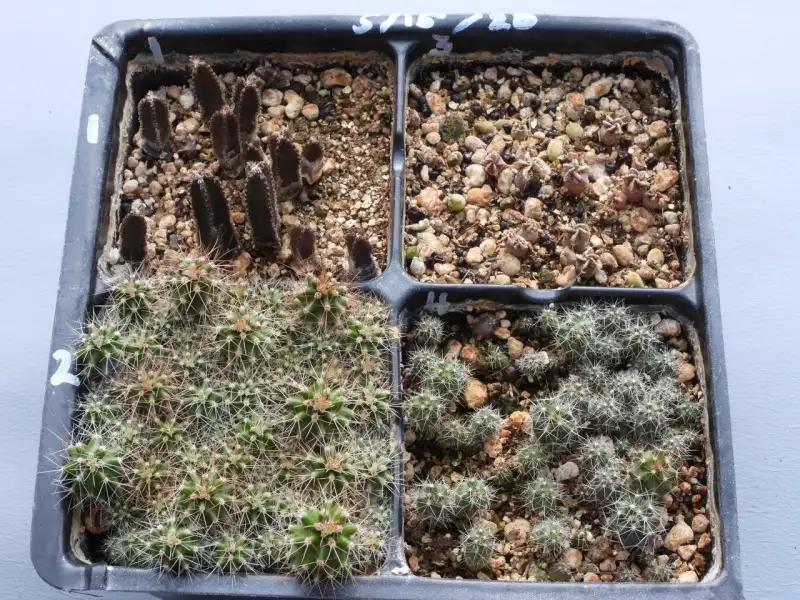
|
May 15, 2020 sowing Set 8
Peniocereus greggii SNL1 (50) max germination count = 16 Count Sept 19 = 15 Astrophytum capricorne (100) max germination count = 40 Count Sept 19 = 30
Echinocereus triglochidiatus (150) max germination count = 84 Count Sept 19 = 58 Escobaria missouriensis SNL155 (150) max germination count = 43 Count Sept 19 = 58
Two weeks later. When I planted, I decided to use only 50 seeds of Peniocereus greggii so that you could easily see the individuals, especially at this stage. The thing to notice is their roughly 400% variation in size. This variation is a common characteristic of plants coming from wild seed. The plants that civilization has domesticated have been selected to minimize variation as much as possible. A farmer plants wheat. Every seed that germinates will do so on the same several days. Very few several days. No farmer wants his wheat field full of various sizes (and ages) of plants. The farmer wants that whole field of wheat growing at the same rate until every stalk ripens at once, or close to at once. The field can then be harvested at once. No farmer wants a wheat field from which he has to harvest wheat stalks of the correct ripeness over two weeks, or more. How could this even be done? Pick the ripe stalks every evening by hand? No way. Look out. Here comes the combine. (I have a friend who is a wheat farmer in Eastern Washington State. He and his brother, with modern equipment, manage a wheat growing farm that covers seven square miles.) Wheat has been selectively bred for about 10,000 years so that everything is uniform. The original wild stock would have been crazily different before the selection by man took place. Darwin was criticized for his theory of evolution by natural selection applied to natural variation. His critics said things don't naturally vary enough to account for species. The critics based their criticism on domesticated plants and animals. Darwin looked at wild (and domestic!!) stocks and saw the necessary variation. So will you, if you stop and look hard.
A few things to notice. The E. triglochidiatus plants are crowding out of their cell. Note how much they've grown in the two weeks since the last picture. (This is called "exponential growth." The whole world will become intimately knowledgable with this mathematical notion as the coronavirus rips through all of our human populations, killing probably millions, that will not wear masks and socially distance.) I know from experience that there are probably many more seedlings in this cell that I can't see and therefore can't count. More germination has happened but these late germinators have been crowded out of the light. When I take this cell apart for transplanting the seedlings, I'll find lots of sickly pale green small things that are hardly recognizable as cacti, never mind E. triglochidiatus. Technically, the runty misshapen things are called "etiolated" plants. In some cases, if given proper light and air, they can be restored to their phenotypical selves, that is, they'll eventually look like E. triglochidiatus plants. The Astrophytum capricorne cell has met some small disaster. There are many fewer plants that at peak germination. Probably some fungus attack happened. Look carefully at the southwest corner of this cell. There is a newly germinated seedling present - the green thing. Germinations four months after the bulk of seeds have germinated is not unusual. Neither is more germination after one year. To repeat something from the Set 1 description: I have never grown Echinocereus triglochidiatus and Escobaria missouriensis next to each other before this. I never noticed how much the two species look alike at this very young stage in their lives. The two species do look different at an earlier stage, as you saw in Set 1. The two are starting to again look different to me. In a few months, the two will look radically different. The Echinocereus triglochidiatus may eventually (years) become 3 feet tall, or more. The Escobaria missouriensis will get about an inch or two tall in that same time interval. The three species of cacti in cells 2, 3, and 4 will eventually get a green epidermis. The Peniocereus greggii will always look brown. In nature, this species stays in the shade of a bush, so it's not set to go green in good light. It stays out of good light if possible.